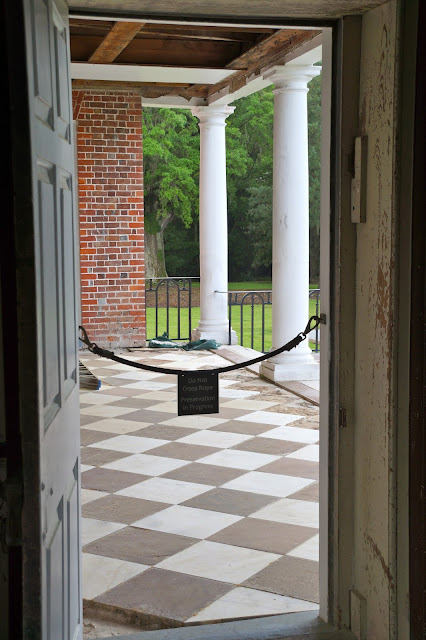DRAYTON HALL allows visitors to experience that setting and use their imagination as the tour guide describes how rooms were used. The house has been preserved, not restored. It is not furnished in order to showcase the structural details.
Begun in 1738, much of its original design has been maintained by seven generations of Draytons. Until 1974 family members continued to live in the Hall with no electricity or plumbing. At that time the National Trust for Historic Preservation acquired the property, opening it to the public in 1977.
The tour starts in the basement where slaves worked, ate, slept and lived. The kitchen and laundry were outbuildings but all other household chores were carried out here.
Upstairs the walls and fireplaces retain the paint and finishes as they were applied over the centuries.
The plaster has been maintained but not re-finished.
Georgian Palladian architectural design required that rooms appear perfectly balanced. If there was a door on the left side of the room then there must be a matching door on the right side. Sometimes there was no reason for a door so a false one was installed.
As recently as 2006 Drayton family members have been buried in a quiet corner of the plantation.
An African American Cemetery on the property is a place of peace and serenity.
Richmond Bowens, a descendent of slaves at Drayton Hall, was born in 1908 and lived and worked at Drayton Hall for over 50 years. He recounted stories of community support in times of illness and death. "THE DEAD CAN ONLY FIND REST AT HOME WITH THE ANCESTORS" is a tradition with roots in Africa. Most of the graves in this cemetery are of Bowens family descendants and in-laws - people whose family history stretches back three centuries in the history of South Carolina.
Mr. Bowens died in 1998 and requested that the cemetery be “left natural”.
As he said: Leave ‘em Rest




















Lovely post. Fascinating seeing this house as it was, naturally. I can actually feel them all walking around there......in those darn hoop skirts.
ReplyDelete